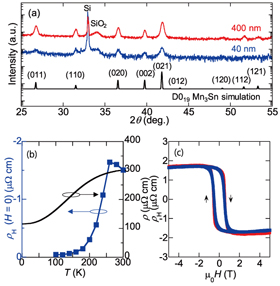Large Anomalous Hall Effect in Thin Films of a Weyl Magnet Mn3Sn
Nakatsuji and Otani Groups
Recently, there has been a surge of interest in antiferromagnets (AFMs) as prospective spintronic materials for high-density and ultrafast memory devices because of their vanishingly small stray field and orders of magnitude faster spin dynamics compared to their ferromagnetic counterparts. In particular, the recently discovered functional antiferromagnet D019 Mn3Sn has attracted broad attention as the first example of a magnetic Weyl material/Weyl magnet [1-5]. This material exhibits a variety of useful functions that have never been observed before in antiferromagnets at zero magnetic field, including the anomalous Hall effect [1], the anomalous Nernst effect [2], and the magneto-optical Kerr effect [5] at room temperature. All these properties are controllable by a magnetic field and thus can be used for designing antiferromagnetic spintronics and in energy harvesting technology. It has been shown that such an antiferromagnet hosts a topological state characterized by magnetic Weyl fermions [3,4]. The discovery of the Weyl metal state in an antiferromagnet opens up a new chapter of applied research using the functional antiferromagnets. Therefore, fabrication of high quality thin films of the Weyl antiferromagnet becomes all the more important.

Fig. 1. (a) Room temperature spectra obtained with an X-ray diffractometer for the 40 and 400 nm thin films of Mn3Sn on a Si/SiO2 substrate. The theoretical spectrum of the D019 Mn3Sn structure is shown at the bottom. (b) Temperature dependence of the resistivity ρ and the spontaneous Hall resistivity ρH of the Mn3Sn (40 nm) thin film. (c) Field dependence of the Hall resistivity ρH measured under a magnetic field applied in the perpendicular direction to the surface of the Mn3Sn thin films.
For the thin film fabrication, we employ DC magnetron sputtering. The films (40-400 nm) are deposited at room temperature onto a Si/SiO2 substrate from the Mn3Sn target. After the deposition at room temperature, we anneal the film at 500ºC for one hour, and thereby crystallizes the as-deposited amorphous film in a polycrystalline form of the Mn3Sn film. XRD measurements reveal that the films are the single phase of Mn3Sn and are in a randomly oriented polycrystalline form; all the peaks can be indexed by the hexagonal P63/mmc symmetry of D019 Mn3Sn, with no additional peaks due to plausible impurity phases (Fig.1(a)).
Figure 1(b) shows the temperature dependence of the longitudinal resistivity ρ and the spontaneous Hall resistivity ρH (H = 0) of the Mn3Sn thin film under zero field. The behavior of longitudinal resistivity ρ confirms the metallic transport consistent with the previous work on bulk single crystals [2]. The zero-field Hall resistivity ρH (H = 0) was obtained from (ρH (H = +0) - ρH (H = -0))/2. (Here, we use +0 and -0 to indicate zero magnetic field approached, respectively, from +5 T and -5 T in the Hall resistivity measurement at each temperature.) We have observed a sharp decrease in ρH (H = 0) below T1 = 260 K on cooling; this behavior agrees with the magnetic symmetry consideration in Mn3Sn that the inverse triangular spin structure breaks the global time-reversal symmetry, whereas time-reversal symmetry is restored in the low temperature helical phase. Figure 1(c) displays the field dependence of the Hall resistivity ρH (H) at 300 K as a function of the magnetic field applied perpendicular to the film surface. The anomalous Hall effect of the Mn3Sn films exhibit a significant change in ρH (H) from 1.5 μΩcm to -1.5 μΩcm with increasing field despite the vanishingly small magnetization; this feature is generated by the switching of the antiferromagnetic domain in real space and the large fictitious field in momentum space [6]. Notably, this is the first report on the thin film of the antiferromagnetic Mn3Sn film exhibiting the large anomalous Hall effect of the same order of magnitude as the value reported for bulk. Our fabrication of the high-quality thin film of the Weyl magnet Mn3Sn and the observation of its large anomalous Hall effect provide an important step to further develop devices useful for antiferromagnetic spintronics, such as for high-speed and high-density information storage.
References
- [1] S. Nakatsuji, N. Kiyohara, and T. Higo, Nature 527, 212 (2015).
- [2] M. Ikhlas, T. Tomita et al., Nat. Phys. 13, 1085 (2017).
- [3] K. Kuroda, T. Tomita et al., Nat. Mater. 16, 1090 (2017).
- [4] H. Yang et al., New J. Phys. 19, 015008 (2017).
- [5] T. Higo et al., Nat. Photon. 12, 73 (2018).
- [6] T. Higo, D. Qu, Y. Li, C. L. Chien, Y. Otani, and S. Nakatsuji, Appl. Phys. Lett. 113, 202402 (2018).
